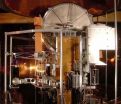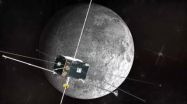Small particles show big promise in beating unpleasant odors
2010-10-28
(Press-News.org) Scientists are reporting development of a new approach for dealing with offensive household and other odors — one that doesn't simply mask odors like today's room fresheners, but eliminates them at the source. Their research found that a deodorant made from nanoparticles — hundreds of times smaller than peach fuzz — eliminates odors up to twice as effectively as today's gold standard. A report on these next-generation odor-fighters appears in ACS' Langmuir, a bi-weekly journal.
Brij Moudgil and colleagues note that consumers use a wide range of materials to battle undesirable odors in clothing, on pets, in rooms, and elsewhere. Most common household air fresheners, for instance, mask odors with pleasing fragrances but do not eliminate the odors from the environment. People also apply deodorizing substances that absorb smells. These materials include activated carbon and baking soda. However, these substances tend to have only a weak ability to absorb the chemicals responsible for the odor.
The scientists describe development of a new material consisting of nanoparticles of silica (the main ingredient in beach sand) — each 1/50,000th the width of a human hair — coated with copper. That metal has well-established antibacterial and anti-odor properties, and the nanoparticles gave copper a greater surface area to exert its effects. Tests of the particles against ethyl mercaptan, the stuff that gives natural gas its unpleasant odor, showed that nanoparticles were up to twice as effective as the gold standard — activated carbon — at removing the material's foul-smelling odor. In addition to fighting odors, the particles also show promise for removing sulfur contaminants found in crude oil and for fighting harmful bacteria, they add.
INFORMATION:
ARTICLE FOR IMMEDIATE RELEASE
"Copper Coated Silica Nanoparticles for Odor Removal"
DOWNLOAD FULL TEXT ARTICLE
http://pubs.acs.org/stoken/presspac/presspac/full/10.1021/la100793u
CONTACT:
Brij Moudgil, Ph.D.
Particle Engineering Research Center
University of Florida
Gainesville, Fla. 32611
Phone: 352-846-1194
Fax: 352-846-1196
Email: bmoudgil@perc.ufl.edu
END
ELSE PRESS RELEASES FROM THIS DATE:
2010-10-28
Move over, touchpad screens: New research funded in part by the National Institutes of Health shows that it is possible to manipulate complex visual images on a computer screen using only the mind.
The study, published in Nature, found that when research subjects had their brains connected to a computer displaying two merged images, they could force the computer to display one of the images and discard the other. The signals transmitted from each subject's brain to the computer were derived from just a handful of brain cells.
"The subjects were able to use their thoughts ...
2010-10-28
Why do some of the one million people who sustain head injuries annually in United States experience a mysterious second wave of brain damage days after the initial injury — just when they appear to be recovering? Limited clinical trials using an innovative new device to monitor brain chemistry on a second-by-second basis are underway to answer that life-and-death question, according to an article in the current issue of Chemical & Engineering News (C&EN), ACS' weekly newsmagazine. Brain injury is the leading cause of death and disability worldwide.
C&EN Senior Editor ...
2010-10-28
Scientists are calling for more research on the possibility that some supposedly healthful plant-based antioxidants — including those renowned for their apparent ability to prevent cancer — may actually aggravate or even cause cancer in some individuals. Their recommendation follows a study in which two such antioxidants — quercetin and ferulic acid — appeared to aggravate kidney cancer in severely diabetic laboratory rats. The study appears in ACS' bi-weekly Journal of Agricultural and Food Chemistry.
Kuan-Chou Chen, Robert Peng, and colleagues note that vegetables, ...
2010-10-28
Extending its 26-year tradition of innovative quantum voltage standards, researchers at the National Institute of Standards and Technology (NIST) have begun shipping a new 10-volt standard to users around the world. The programmable system measures both direct current (DC) and alternating current (AC) voltages.
NIST AC/DC 10-volt standard chip.
The new 10-volt system* builds on a number of previous NIST inventions, from the initial 1-volt standard in 1984 through the 2006 unveiling of the world's first precision instrument for directly measuring AC voltages.** Because ...
2010-10-28
Better psychological and spiritual support, improved planning of care and stronger relationships with physicians are necessary to improve end-of-life care in Canada, according to a study by a Queen's University professor.
"High quality end-of-life care should be the right of every Canadian," says professor of Medicine and Epidemiology Daren Heyland, who is also a researcher at Kingston General Hospital. "But it's not always happening. We know from international studies that Canada ranks ninth in the world in terms of quality of care provided at the end of life."
The study, ...
2010-10-28
Taking the first steps of what would be a major historical advance in the science of measurement, the National Institute of Standards and Technology (NIST) is participating in a worldwide effort to recommend major revisions to the International System of Units (SI), the modern metric system that is the basis of global measurements in commerce, science and other aspects of everyday life. The new SI, which would be based on seven constants of nature, would enable researchers around the world to express the results of measurements at new levels of consistency and accuracy.
The ...
2010-10-28
Cockroaches can skitter through a crowded under-the-sink cabinet, eluding capture or worse, making the insects a model for rescue robots that would creep through the debris of disaster in search of survivors.
But learning how they use all six legs at the same time to walk, run and turn has been a difficult and time-consuming task. Until now.
Using a pair of high-speed cameras and a custom computer program, researchers at Case Western Reserve University are able to simultaneously extract three-dimensional movement of a cockroach's 26 leg joints. They report their findings ...
2010-10-28
Texas A&M University is one of 10 international partners involved in the global conservation study and subsequent scientific paper, "The Impact of Conservation on the Status of the World's Vertebrates," that is scheduled to be published in Science, the academic journal of the American Association for the Advancement of Science.
Dr. Thomas E. Lacher, Jr., Texas A&M University's wildlife and fisheries sciences department head at College Station, Texas and a coauthor, said the report reviews the current status of thousands of species in light of the 2010 target of the Convention ...
2010-10-28
Two micro-satellites originally launched into Earth's orbit in 2007 by NASA have been redirected by University of California, Berkeley, scientists toward new orbits around the moon, extending study of the earth and moon's interaction with the solar wind.
The second of the two probes settled into a temporary "Lagrange-point" orbit on Friday, Oct. 22, inaugurating science operations for a new mission dubbed ARTEMIS – Acceleration, Reconnection, Turbulence, and Electrodynamics of the Moon's Interaction with the Sun.
Lagrange points are places where the gravity of Earth ...
2010-10-28
Researchers at North Carolina State University have found that the overproduction of a key protein in stem cells causes those stem cells to form cancerous tumors. Their work may lead to new treatments for a variety of cancers.
Dr. Jon Horowitz, associate professor of molecular biomedical sciences, and a team of NC State researchers looked at the protein SP2, which regulates the activity of other genes. They knew that elevated amounts of SP2 had been observed in human prostate-cancer patients, and that these levels only increased as the tumors became more dangerous. They ...
LAST 30 PRESS RELEASES:
[Press-News.org] Small particles show big promise in beating unpleasant odors


